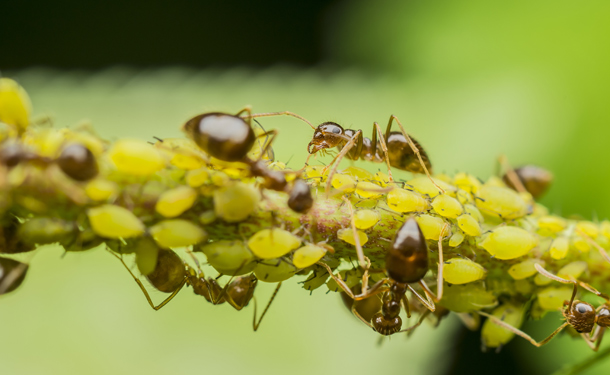The aphid is a dangerous plant pest. It can harm a plant slowly, and if the necessary curative measures are not taken, it can spread and start affecting other nearby plants and trees. They have the ability to drain the sap and destroy the flowers and stems of a plant. As aphids feed on plants, they can spread the virus to them, and they excrete honeydew, which causes the growth of sooty mold. This thetreecareguide.com article covers identifying aphids and solutions to deter them from inhabiting and damaging your trees and plants.

How To Identify Aphid Infestation
Aphids have different colors ranging from black, green, red, brown or yellow depending on their species. Their bodies are pear-shaped, and they can easily be identified with their long antenna and legs. Aphids can be distinguished from other insects by their cornicles, (two tube-like projections at the back of their body).
Some species secrete grayish or white substances from the surface of their body; hence they appear wooly or wax-like. A few species of aphids may have wings due to over-population or weather variations, but generally, the adults are wingless. Possession of wings creates an avenue for aphids to disperse to many locations in search of plants to destroy.
Bait to Keep Protective Ants Away From Aphids
Aphids and many ant species share a kind of symbiotic relationship. This is because when aphids feed on plants, they secrete honeydew, and ants feed on the honeydew. To maintain their supply of honeydew, the ants protect the aphids from destruction by predators.
To expose the aphids and make them vulnerable to predators such birds, you need to draw the ants away, for instance by baiting them with honey. When the ants move away from the castle where they protect the aphids, the aphids can then be destroyed by predators.
When you see ants climbing a tree infested with plants, you have to stop them from getting to the aphids by rubbing a sticky material on the tree, such that the material traps them and prevents them from going further up. However, you need to be careful not to put the material on the bark of a young or pruned plant, as it may be harmful to the plant. The best way to go about it is to wrap a fabric or duct tape around the tree bark and apply the sticky material on the tape or fabric.
Also, you can put baits in containers and drop them on the ground to distract insects or cut off some branches touching the ground, other trees or the roof of buildings.
Solutions to Control Aphids
Use of Soap and Water – Soaps are basic in nature and can be used in fighting aphids. To do this, you have to dissolve a small amount of soap in water and sprinkle the solution on the aphid infested plants. You also need to make sure that you sprinkle it on the back of leaves and other places smaller aphids and their eggs and larvae may be hiding. The soap dissolves the waxy substance on the body of the aphids and exposes them to dehydration and consequently, death. This way, you can fight aphids without affecting the plant itself.
Caution should be taken when using this method, because if the soap is applied indiscriminately, it may kill other beneficial species of insects, which can prey on aphids, such as ladybug, lacewings, and hoverflies, and killing of these predators make it easier for new sets of aphids to colonize the plant.
Insecticides – The best choice in fighting aphids is the use insecticidal soaps and petroleum-derived oils like canola oil and neem. They destroy the aphids by suffocating them. Hence it is necessary to apply them thoroughly on the affected areas. 1 to 2% solution of the oil is to be mixed with water and applied thoroughly, paying special attention to the top and underneath the leaves.
The product kills aphids that are present the moment they are sprayed, their toxicity does not persist, so it is necessary to repeat the application. Some natural enemies of aphids present at the time of spraying may also be killed, as their toxicity does not persist, hence natural enemies can migrate to the plant afterward.
Use of Aphids Natural Enemies – You can eliminate aphids from your garden by introducing some natural enemies such as lacewings and ladybugs. These natural enemies can be bought from vendors, or lured into the garden using their individual foods.
Visit thetreecareguide.com/pest-prevention-treatment-tips/ for more pest prevention tips.
Working Towards An Ecosystem Free From Infestation
The best way to maintain your garden and not to worry over the population of aphids is by creating a balance between host plants, prey, and predators.
The best way to control aphids is not by totally killing all aphids in your garden, because when they are totally destroyed, their natural predators migrate away from the farm to other places where they can find food, thereby leaving your farm vulnerable.
The most advisable thing to do is to not over-shelter, over-fertilize or over-pamper your plants, instead, allow them to and adapt strongly to the environment such that they can naturally heal from mild damages caused by insects.
Source(s):
http://www.72tree.com/using-dormant-horticultural-oil-treat-tree-insect-infestations/
http://www.naturallivingideas.com/12-organic-ways-get-rid-aphids/
http://ipm.ucanr.edu/PMG/PESTNOTES/pn7404.html